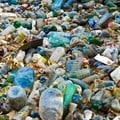I have been watching the Clover blue milk bottle campaign and the outrage it is causing amongst civil society and environmental organisations, the professionals, activists and concerned citizens who are doing everything possible to educate and clean up the scourge of plastic pollution that is choking our rivers, wetlands and oceans.
So, when one of South Africa’s most well-known brands, Clover, decided to ‘make fresh milk relevant again’ by putting it in a blue bottle with a blue lid – during Plastic Free July – I was left astonished.
This is the most perfect example of the disconnection between corporate ‘values’ and their greenwashing promises that are meant to lull a consumer into a false sense of security about the products that are produced. This campaign is a stark reminder to brands that sustainability is not a nice to have – it is the only strategy a brand should be contemplating in product and packaging development.
For the past five years I have been delivering a guest lecture series to the final year marketing and advertising students at The Red and Yellow School of Creative Business. It is a synopsis of over ten years of experience in communicating what sustainability is and how brands of the future will help address the environmental, economic, and social problems facing our society today.
They will achieve this by circular product development and by stepping up to being an effective and contributing corporate citizen, accountable for what they make and the products’ impacts on the environment and society.
Ultimate guide to greenwashing
The Clover campaign provides the ultimate guide to what greenwashing is, but more soberly, the impacts are yet to be felt.
Its strategy was to ‘make milk more relevant’? So, the decision was to turn the bottle and lid blue so that it stands out more on the shelves. What happens after that?
What happens to the millions of low value recycling plastics that are not making their way into the recycling stream for various complex factors that include zero waste collection, little or no value to the recycled material itself and no producer accountability for the waste generated.
The bottle that is now being marketed is made of a type of plastic that can be recycled but its value is far less than that of the standard white HDPE bottle that is used in many domestic packaging.
The recycling sector in this country is one of the many at its knees. This sector supports thousands of informal jobs and these men and women who retrieve the trash will get paid less for this blue HDPE or possibly overlook collecting it at all due to its reduced value.
I wonder if the Clover marketing team considered this or whether they even had a conversation about the bottle’s impacts and, if so, are they are reconsidering their choices.
Irrelevant and harmful
Currently there is a draft regulation in circulation that will make the producer responsible for their waste. You have only to go near the river mouths at the end of a huge storm to witness first-hand the tide of pollution making it into the oceans from the over-polluted and rivers and wetlands.
When you work closely with those who have attempted to establish recycling entities to employ thousands of jobless people, or those who work and rehabilitate marine creatures after they have either been entangled in or have ingested plastic, it is difficult not to get angry by this apparent act of disregard for the impact this blue bottle will have.
Instead of using an opportunity to make 'more out of milk', working to create a campaign that offered true shared value it looks like marketing hijacked sustainability and turned it blue.
Blue is the colour of human asphyxiation and after the rivers and wetlands have truly been choked by plastic pollution at least there will be a branding opportunity and these bottles will be seen for what they are: irrelevant and harmful in their societal and environmental impacts.
Stemming the tide of water pollution
With more than 17,000 miles of coastline, South Africa has a deep connection with the sea. However, the country is the 11th worst plastic polluter in the world, according to a 2015 study.
This month, on Going Green, CNN meets the scientists and entrepreneurs from across the globe who are stemming the tide for water pollution. They are working tirelessly to find solutions that could reshape some of the world’s wasteful industries and protect the planet’s waterways and sea life. The pollution of water resources is a big danger especially at a time like Covid-19 where water is one of the most important resources.
This video sheds light on the pollution of water in South Africa and how entrepreneurs and scientists are working tirelessly to tackle this problem.










































